Re-Os Geochronology and Sulfur Isotopes of the Lyangar W-Mo Deposit: Implications for Permian Tectonic Setting in South Tianshan Orogen, Uzbekistan
Abstract
:1. Introduction
2. Regional Geology
3. Deposit Geology
4. Analytical Methods
4.1. Molybdenite Re-Os Isotope Analysis
4.2. Sulfur Isotopes
5. Results
5.1. Molybdenite Re-Os Isotopes
5.2. Sulfur Isotopic Compositions
6. Discussion
6.1. Timing of Mineralization
6.2. Source of Ore-Forming Components
6.3. Mineralization and Tectonic Setting
7. Concluding Remarks
Author Contributions
Funding
Acknowledgments
Conflicts of Interest
References
- Meinert, L.D.; Dipple, G.M.; Nicolescu, S. World skarn deposits. Econ. Geol. 2005, 100, 299–336. [Google Scholar]
- Romer, R.L.; Kroner, U. Phanerozoic tin and tungsten mineralization—Tectonic controls on the distribution of enriched protoliths and heat sources for crustal melting. Gondwana Res. 2016, 31, 60–95. [Google Scholar] [CrossRef]
- Deng, X.H.; Chen, Y.J.; Santosh, M.; Wang, J.B.; Li, C.; Yue, S.W.; Zheng, Z.; Chen, H.J.; Tang, H.S.; Dong, L.H.; et al. U-Pb zircon, Re-Os molybdenite geochronology and Rb-Sr geochemistry from the Xiaobaishitou W(-Mo) deposit: Implications for Triassic tectonic setting in eastern Tianshan, NW China. Ore Geol. Rev. 2017, 80, 332–351. [Google Scholar] [CrossRef]
- Sengör, A.M.C.; Natalin, B.A.; Burtman, V.S. Evolution of the Altaid tectonic collage and Paleozoic crustal growth in Eurasia. Nature 1993, 364, 299–307. [Google Scholar] [CrossRef]
- Gao, J.; Klemd, R.; Qian, Q.; Zhang, X.; Li, J.; Jiang, T.; Yang, Y. The collision between the Yili and Tarim blocks of the Southwestern Altaids: geochemical and age constraints of a leucogranite dike crosscutting the HP-LT metamorphic belt in the Chinese Tianshan Orogen. Tectonophysics 2011, 499, 118–131. [Google Scholar] [CrossRef]
- Sillitoe, R.H. A plate tectonic model for the origin of porphyry copper deposits. Econ. Geol. 1972, 67, 184–197. [Google Scholar] [CrossRef]
- Pirajno, F. Hydrothermal Processes and Mineral System; Springer: Berlin, Germany, 2009; pp. 1–1250. [Google Scholar]
- Pirajno, F. The Geology and Tectonic Settings of China’s Mineral Deposits; Springer: Berlin, Germany, 2013; pp. 1–679. [Google Scholar]
- Mao, S.D.; Chen, Y.J.; Zhou, Z.J.; Lu, Y.H.; Guo, J.H.; Qin, Y.; Yu, J.Y. Zircon geochronology and Hf isotope geochemistry of the granitoids in the Yangshan gold field, western Qinling, China: Implications for petrogenesis, ore genesis and tectonic setting. Geol. J. 2014, 49, 359–382. [Google Scholar] [CrossRef]
- Zhou, Z.J.; Liu, Z.W.; Qin, Y. Geology, geochemistry and genesis of the Huachanggou gold deposit, western Qinling Orogen, central China. Geol. J. 2014, 49, 424–441. [Google Scholar] [CrossRef]
- Chen, Y.J. Progress in the study of Central Asia-type orogenesis-metallogenesis in Northwest China. J. China Univ. Geosci. 2000, 6, 17–22, (In Chinese with English Abstract). [Google Scholar]
- Chen, Y.J. Orogenic-type deposits and their metallogenic model and exploration potential. Geol. China 2006, 33, 1181–1196, (In Chinese with English Abstract). [Google Scholar]
- Chen, Y.J. Indosinian tectonic setting, magmatism and metallogenesis in Qinling Orogen, central China. Geol. China 2010, 37, 854–865, (In Chinese with English Abstract). [Google Scholar]
- Chen, Y.J. The development of continental collision metallogeny and its application. Acta Petrol. Sin. 2013, 29, 1–17, (In Chinese with English Abstract). [Google Scholar]
- Chen, Y.J.; Fu, S.G. Gold Mineralization in West Henan, China; Seismological Press: Beijing, China, 1992; pp. 1–234, (In Chinese with English Abstract). [Google Scholar]
- Chen, Y.J.; Santosh, M. Triassic tectonics and mineral systems in the Qinling Orogen, central China. Geol. J. 2014, 49, 338–358. [Google Scholar] [CrossRef]
- Chen, Y.J.; Santosh, M.; Somerville, I.D.; Chen, H.Y. Indosinian tectonics and mineral systems in China: An introduction. Geol. J. 2014, 49, 331–337. [Google Scholar] [CrossRef]
- Abzalov, M. Zarmitan granitoid-hosted gold deposit, Tian Shan Belt, Uzbekistan. Econ. Geol. 2007, 102, 519–532. [Google Scholar] [CrossRef]
- Bierlein, F.; Wilde, A. New constraints on the polychronous nature of the giant Muruntau gold deposit from wall-rock alteration and ore paragenetic studies. J. Geol. Soc. Aust. 2010, 57, 839–854. [Google Scholar] [CrossRef]
- Chen, Z.L.; Zhou, Y.G.; Han, F.B.; Chen, B.L.; Hao, R.X.; Li, S.B.; Liu, Z.R. Exhumation degree of the Tianshan Range and its implications for ore preservation. J. China Univ. Geosci. 2012, 37, 903–916, (In Chinese with English Abstract). [Google Scholar]
- Goldfarb, R.J.; Taylor, R.D.; Collins, G.S.; Goryachev, N.A.; Orlandini, O.F. Phanerozoic continental growth and gold metallogeny of Asia. Gondwana Res. 2014, 25, 48–102. [Google Scholar] [CrossRef]
- Li, H.H.; Qiu, R.Z.; Tan, Y.J.; Qi, S.j.; Wang, Q.M.; Wang, K.A.; Wang, H.P.; Wang, J.J.; Yuan, C.H.; Chen, S.D. The Exploration and Development Guidelines of Mineral Resources in the Five Countries in Central Asian; China University of Geosciences Press: Wuhan, China, 2010; pp. 1–207. (In Chinese) [Google Scholar]
- Yao, W.G.; Lv, P.R.; Wu, L.; Hong, J.; Yang, B.; Jia, Q.Z.; Li, B.Q. Geological characteristics of dominant mineral resources of the Tianshan Mountains in Kyrgyzstan and their prospecting potential. Geol. Bull. China 2015, 34, 710–725, (In Chinese with English Abstract). [Google Scholar]
- Mirkamalov, R.H.; Golovanov, I.M.; Chirikin, V.V.; Phadeicheva, L.P.; Mirkamalova, G.H. Altas of Ore Deposits Models of Uzbekistan; PrintXpress: Tashkent, Uzbekistan, 2011; pp. 1–100. [Google Scholar]
- Stein, H.J.; Markey, R.J.; Morgan, J.W.; Hannah, J.L.; Schersten, A. The remarkable Re-Os chronometer in molybdenite: How and why it works. Terra Nova 2001, 13, 479–486. [Google Scholar] [CrossRef]
- Conliffe, J.; Selby, D.; Porter, S.J.; Feely, M. Re-Os molybdenite dates from the Ballachulish and Kilmelford igneous complexes (Scottish Highlands): Age constraints for late Caledonian magmatism. J. Geol. Soc. Lond. 2010, 167, 297–302. [Google Scholar] [CrossRef]
- Chen, Y.J.; Pirajno, F.; Sui, Y.H. Isotope geochemistry of the Tieluping silver deposit, Henan, China: A case study of orogenic silver deposits and related tectonic setting. Mineral. Depos. 2004, 39, 560–575. [Google Scholar] [CrossRef]
- Chen, Y.J.; Pirajno, F.; Qi, J.P. The Shanggong gold deposit, eastern Qinling Orogen, China: Isotope geochemistry and implications for ore genesis. J. Asian Earth Sci. 2008, 33, 252–266. [Google Scholar] [CrossRef]
- Yang, Y.F.; Chen, Y.J.; Li, N.; Mi, M.; Xu, Y.L.; Li, F.L.; Wan, S.Q. Fluid inclusion and isotope geochemistry of the Qian’echong giant porphyry Mo deposit, Dabie Shan, China: A case of NaCl-poor, CO2-rich fluid systems. J. Geochem. Explor. 2013, 124, 1–13. [Google Scholar] [CrossRef]
- Zhou, Z.J.; Chen, Y.J.; Jiang, S.Y.; Zhao, H.X.; Qin, Y.; Hu, C.J. Geology, geochemistry and ore genesis of the Wenyu gold deposit, Xiaoqinling gold field, southern margin of North China Craton. Ore Geol. Rev. 2014, 59, 1–20. [Google Scholar] [CrossRef]
- Zhou, Z.J.; Chen, Y.J.; Jiang, S.Y.; Hu, C.J.; Qin, Y.; Zhao, H.X. Isotope and fluid inclusion geochemistry and ore genesis of the Qiangma gold deposit, Xiaoqinling gold field, Qinling Orogen, southern margin of North China Craton. Ore Geol. Rev. 2015, 66, 47–64. [Google Scholar] [CrossRef]
- Deng, X.H.; Chen, Y.J.; Santosh, M.; Yao, J.M.; Sun, Y.L. Re-Os and Sr-Nd-Pb isotope constraints on source of fluids in the Zhifang Mo deposit, Qinling Orogen, China. Gondwana Res. 2016, 30, 132–143. [Google Scholar] [CrossRef]
- Zhou, Z.J.; Chen, Z.L.; Han, F.B.; Han, S.Q.; Wang, Z.X.; Xiao, W.F.; Shen, T.; Wu, J.F. Fluid inclusion and isotope geochemistry of the Atebayue Sb deposit, South Tianshan Orogen, Kyrgyzstan. Geol. J. 2018, 53, 1050–1060. [Google Scholar] [CrossRef]
- Gao, J.; Long, L.; Klemd, R.; Qian, Q.; Liu, D.; Xiong, X.; Su, W.; Liu, W.; Wang, Y.; Yang, F. Tectonic evolution of the South Tianshan orogen and adjacent regions, NW China: Geochemical and age constraints of granitoid rocks. Int. J. Earth Sci. 2009, 98, 1221–1238. [Google Scholar] [CrossRef]
- Zhang, G.Z.; Xue, C.J.; Chi, G.X.; Liu, J.Y.; Zhao, X.B.; Zu, B.; Zhao, Y. Multiple-stage mineralization in the Sawayaerdun orogenic gold deposit, western Tianshan, Xinjiang: Constraints from paragenesis, EMPA analyses, Re-Os dating of pyrite (arsenopyrite) and U-Pb dating of zircon from the host rocks. Ore Geol. Rev. 2017, 81, 326–341. [Google Scholar] [CrossRef]
- Chen, Z.L.; Wang, Z.X.; Han, F.B.; Zhang, W.G.; Zhang, Q.; Zhou, Z.J.; Wang, X.H.; Xiao, W.F.; Han, S.Q.; Yu, X.Q.; et al. Late Cretaceous–Cenozoic uplift, deformation, and erosion of the SW Tianshan Mountains in Kyrgyzstan and Western China. Int. Geol. Rev. 2017, 60, 1–19. [Google Scholar] [CrossRef]
- Seltmann, R.; Konopelko, D.; Biske, G.; Divaev, F.; Sergeev, S. Hercynian post-collisional magmatism in the context of Paleozoic magmatic evolution of the Tien Shan orogenic belt. J. Asian Earth Sci. 2011, 42, 821–838. [Google Scholar] [CrossRef]
- Yakubchuk, A.; Cole, A.; Seltmann, R.; Shatov, V. Tectonic setting, characteristics, and regional exploration criteria for gold mineralization in the Altaid orogenic collage: The Tien Shan province as a key example. Soc. Econ. Geol. Spec. Publ. 2002, 9, 177–201. [Google Scholar]
- Markey, R.; Stein, H.; Morgan, J. Highly precise Re-Os dating for molybdenite using alkaline fusion and NTIMS. Tala 1998, 45, 935–946. [Google Scholar] [CrossRef]
- Du, A.D.; He, H.L.; Yin, N.W.; Zou, X.Q.; Sun, Y.L.; Sun, D.Z.; Chen, S.Z.; Qu, W.J. Direct dating of molybdenites using the Re-Os geochronometer. Chinese Sci. Bull. 1993, 38, 1319–1320. [Google Scholar]
- Ludwig, K.R. User’s Manual for Isoplot 3.00: A Geochronological Toolkit for Microsoft Excel; Berkeley Geochronology Center Special Publication: Berkeley, CA, USA, 2003; pp. 1–70. [Google Scholar]
- Stein, H.J.; Markey, R.J.; Morgan, J.W.; Selby, D.; Creaser, R.A.; McCuaig, T.C.; Behn, M. Re-Os Dating of Boddington Molybdenites, SW Yilgarn: Two Au Mineralization Events. AGSO-Geoscience Australia, Record 37. 2001, pp. 469–471. Available online: https://pdfs.semanticscholar.org/2db8/8466818aa6fe5e71fdc8845bb889b8887c7d.pdf?_ga=2.109284997.1685928020.1567236989-838078150.1553161399 (accessed on 31 August 2019).
- Chen, Y.J.; Wang, P.; Li, N.; Yang, Y.F.; Pirajno, F. The collision-type porphyry Mo deposits in Dabie Shan, China. Ore Geol. Rev. 2017, 81, 405–430. [Google Scholar] [CrossRef]
- Li, N.; Chen, Y.J.; Santosh, M.; Yao, J.M.; Sun, Y.L.; Li, J. The 1.85 Ga Mo mineralization in the Xiong’er Terrane, China: Implications for metallogeny associated with assembly of the Columbia supercontinent. Precambrian Res. 2011, 186, 220–232. [Google Scholar] [CrossRef]
- Yang, Y.F.; Wang, P. Geology, geochemistry and tectonic settings of molybdenum deposits in southwestern China: A review. Ore Geol. Rev. 2017, 81, 965–995. [Google Scholar] [CrossRef]
- Wu, Y.S.; Chen, Y.J.; Zhou, K.F. Mo deposits in Northwest China: Geology, geochemistry, geochronology and tectonic setting. Ore Geol. Rev. 2017, 81, 641–671. [Google Scholar] [CrossRef]
- Zheng, Y.; Cai, X.; Ding, Z.J.; Cawood, P.A.; Yue, S.W. Geology, geochronology and isotopic geochemistry of the Xiaoliugou W-Mo ore field in the Qilian Orogen, NW China: Case study of a skarn system formed during continental collision. Ore Geol. Rev. 2017, 81, 575–586. [Google Scholar] [CrossRef]
- Hoefs, J. Stable Isotope Geochemistry, 6th ed.; Springer-Verlag: Berlin/Heidelberg, Germany, 2009; pp. 48–54. [Google Scholar]
- Chen, H.Y.; Chen, Y.J.; Baker, M.J. Evolution of ore-forming fluids in the Sawayaerdun gold deposit in the Southwestern Chinese Tianshan metallogenic belt, Northwest China. J. Asian Earth Sci. 2012, 49, 131–144. [Google Scholar] [CrossRef]
- Chen, H.Y.; Chen, Y.J.; Baker, M.J. Isotopic geochemistry of the Sawayaerdun orogenic-type gold deposit, Tianshan, northwest China: Implications for ore genesis and mineral exploration. Chem. Geol. 2012, 310–311, 1–11. [Google Scholar] [CrossRef]
- Xue, C.J.; Zhao, X.B.; Mo, X.X.; Chen, Y.C.; Dong, L.H.; Gu, X.X.; Zhang, Z.C.; Nurtaev, B.; Pak, N.; Li, Z.D.; et al. Tectonic-metallogenic evolution of western Tianshan giant Au-Cu-Zn-Pb metallogenic belt and prospecting orientation. Acta Geol. Sin. 2014, 88, 2490–2531, (In Chinese with English Abstract). [Google Scholar]
- Mörelli, R.; Creaser, R.A.; Seltmann, R.; Stuart, F.M.; Selby, D.; Graupner, T. Age and source constraints for the giant Muruntau gold deposit, Uzbekistan, from coupled Re-Os-He isotopes in arsenopyrite. Geology 2007, 35, 795–798. [Google Scholar] [CrossRef]
- Zhao, R.F.; Yang, J.G.; Wang, M.C.; Yao, W.G. The study of metallogenic geologic setting and prospecting potential evaluation in Southwestern Tianshan Mountains. Northwest. Geol. 2002, 35, 101–121, (In Chinese with English Abstract). [Google Scholar]
- Li, H.Q.; Chen, F.W. Isotopic Geochronology of Regional Mineralization in Xinjiang, China; Geological Publishing House: Beijing, China, 2004; pp. 1–391, (In Chinese with English Abstract). [Google Scholar]
- Xiao, W.J.; Zhang, L.C.; Qin, K.Z.; Sun, S.; Li, J.L. Paleozoic accretionary and collisional tectonics of the eastern Tianshan (CHINA): Implications for the continental growth of Central Asia. Am. J. Sci. 2004, 304, 370–395. [Google Scholar] [CrossRef]
- Xiao, W.J.; Han, C.M.; Yuan, C.; Chen, H.L.; Sun, M.; Lin, S.F.; Li, Z.L.; Mao, Q.G.; Zhang, J.E.; Sun, S.; et al. The unique Carboniferous–early Permian tectonic-metallogenic framework of Northern Xinjiang (NW China): Constraints for the tectonics of the southern Paleoasian Domain. Acta Petrol. Sin. 2006, 22, 1062–1076, (In Chinese with English Abstract). [Google Scholar]
- Solomovich, L.I. Post collisional magmatism in the South Tien Shan Variscan orogenic belt, Kyrgyztan: Evidence for high-temperature and high-pressure collision. J. Asian Earth Sci. 2007, 30, 142–153. [Google Scholar] [CrossRef]
- Konopelko, D.; Biske, G.; Seltmann, R.; Eklun, O.; Belyatsky, B. Hercynian postcollisional A-type granites of the Kokshaal Range, Southern Tien Shan. Lithos 2007, 97, 140–160. [Google Scholar] [CrossRef]
- Brookfield, M.E. Geological development and Phanerozoic crustal accretion in the western segment of the southern Tien Shan (Kyrgyzstan, Uzbekistan and Tajikistan). Tectonophysics 2000, 328, 1–14. [Google Scholar] [CrossRef]
- Zhang, L.F.; Ai, Y.L.; Li, X.P.; Rubatto, D.; Song, B.; Williams, S.; Song, S.G.; Ellis, D.; Liou, J.G. Triassic collision of western Tianshan orogenic belt, China: Evidence from SHRIMP U-Pb dating of zircon from HP/UHP eclogitic rocks. Lithos 2007, 96, 266–280. [Google Scholar] [CrossRef]
- Zhang, L.F.; Ai, Y.L.; Song, S.G.; Liou, J.; Wei, C.J. A brief review of UHP meta-ophiolitic rocks, Southwestern Tianshan, Western China. Int. Geol. Rev. 2007, 49, 811–823. [Google Scholar] [CrossRef]
- Kempe, U.; Seltmann, R.; Graupner, T.; Wall, V.J.; Matukov, D.; Sergeev, S. SHRIMP U-Pb zircon dating of Hercynian granite magmatism in the Muruntau gold district (Uzbekistan). In Proceedings of the Interim International Association on the Genesis of Ore Deposits Conference, Vladivostok, Russia, 1–20 September 2004; pp. 210–213, (Abstracts). [Google Scholar]
- Nenakhov, V.M.; Ivanikov, V.V.; Kuznetsov, L.V. Osobennosty Izucheniya I Kartirovaniya Kollisionnikh Granitoidov (the Study and Mapping of the Collisional Granitoids); Roscomnedra Press: Moskow, Russian, 1992; pp. 1–100. (In Russian) [Google Scholar]
- Solomovich, L.I.; Trifonov, B.A. Postcollisional granites in the South Tien Shan Variscan collisional belt, Kyrgyzstan. J. Asian Earth Sci. 2002, 21, 7–21. [Google Scholar] [CrossRef]
- Mao, J.W.; Konopelko, D.; Seltmann, R.; Lehmann, B.; Chen, W.; Wang, Y.T.; Eklund, O.; Usubaliev, T. Postcollisional age of the Kumtor gold deposit and timing of Hercynian events in the Tien Shan, Kyrgyzstan. Econ. Geol. 2004, 99, 1771–1780. [Google Scholar] [CrossRef]
- Long, L.L.; Gao, J.; Qian, Q.; Xiong, X.M.; Wang, J.B.; Wang, Y.W.; Wang, L.J. Geochemistry and SHRIMP zircon U-Pb age of post-collisional granites in the southwest Tianshan Orogenic Belt of China: examples from the Heiyingshan and Laohutai plutons. Acta Geol. Sin. 2008, 82, 415–424. [Google Scholar]
- Wang, C.; Liu, L.; Luo, J.H.; Che, Z.Z.; Teng, Z.H.; Cao, X.D.; Zhang, J.Y. Late Paleozoic post-collisional magmatism in the Southwestern Tianshan orogenic belt, take the Baleigong pluton in the Kokshal region as an example. Acta Petrol. Sin. 2007, 23, 1830–1840, (In Chinese with English Abstract). [Google Scholar]
- Huang, H.; Wang, T.; Qin, Q.; Tong, Y.; Guo, L.; Zhang, L.; Hou, J.Y.; Song, P. Geochronology and zircon Hf isotope of Baleigong granitic pluton in the western part of the South Tianshan Mountains: Petrogenesis and implications for tectonic evolution. Acta Petrol. Mineral. 2015, 34, 971–990, (In Chinese with English Abstract). [Google Scholar]
- Huo, H.L.; Chen, Z.L.; Zhang, Q.; Han, F.B.; Zhang, W.G.; Tang, Y.W. Chronological constraints on late Paleozoic collision in the southwest Tianshan orogenic belt, China: Evidence from the Baleigong granite. Acta Geol. Sin. accepted.
- Soloviev, S.G.; Kryazhev, S.G. Magmatic-hydrothermal evolution at the Lyangar redox-intermediate tungsten-molybdenum skarn deposit, western Uzbekistan, Tien Shan: Insights from igneous petrology, hydrothermal alteration, and fluid inclusion study. Lithos 2018, 316–317, 154–177. [Google Scholar] [CrossRef]
- De Grave, J.D.; Glorie, S.; Ryabinin, A.; Zhimulev, F.; Buslov, M.M.; Izmer, A.; Elburg, M.; Vanhaecke, F.; Van den haute, P. Late Palaeozoic and Meso-Cenozoic tectonic evolution of the southern KyrgyzTien Shan: Constraints from multi-method thermochronology in the Trans-Alai, Turkestan-Alai segment and the southeastern Ferghana Basin. J. Asian Earth Sci. 2012, 44, 149–168. [Google Scholar] [CrossRef]
- Han, B.F.; He, G.Q.; Wang, X.C.; Guo, Z.J. Late Carboniferous collision between the Tarim and Kazakhstan–Yili terranes in the western segment of the South Tian Shan Orogen, Central Asia, and implications for the Northern Xinjiang, western China. Earth Sci. Rev. 2011, 109, 74–93. [Google Scholar] [CrossRef]
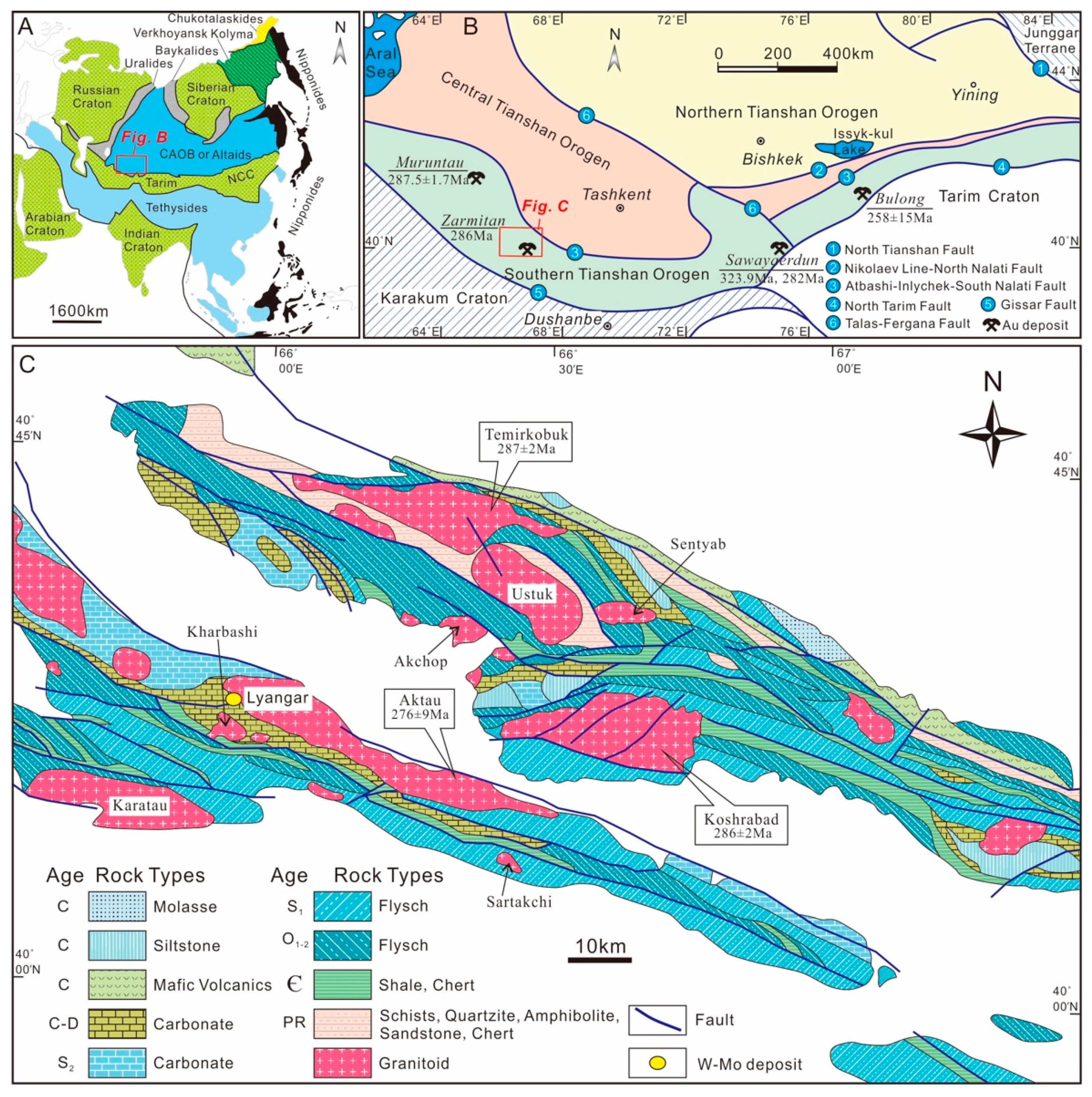
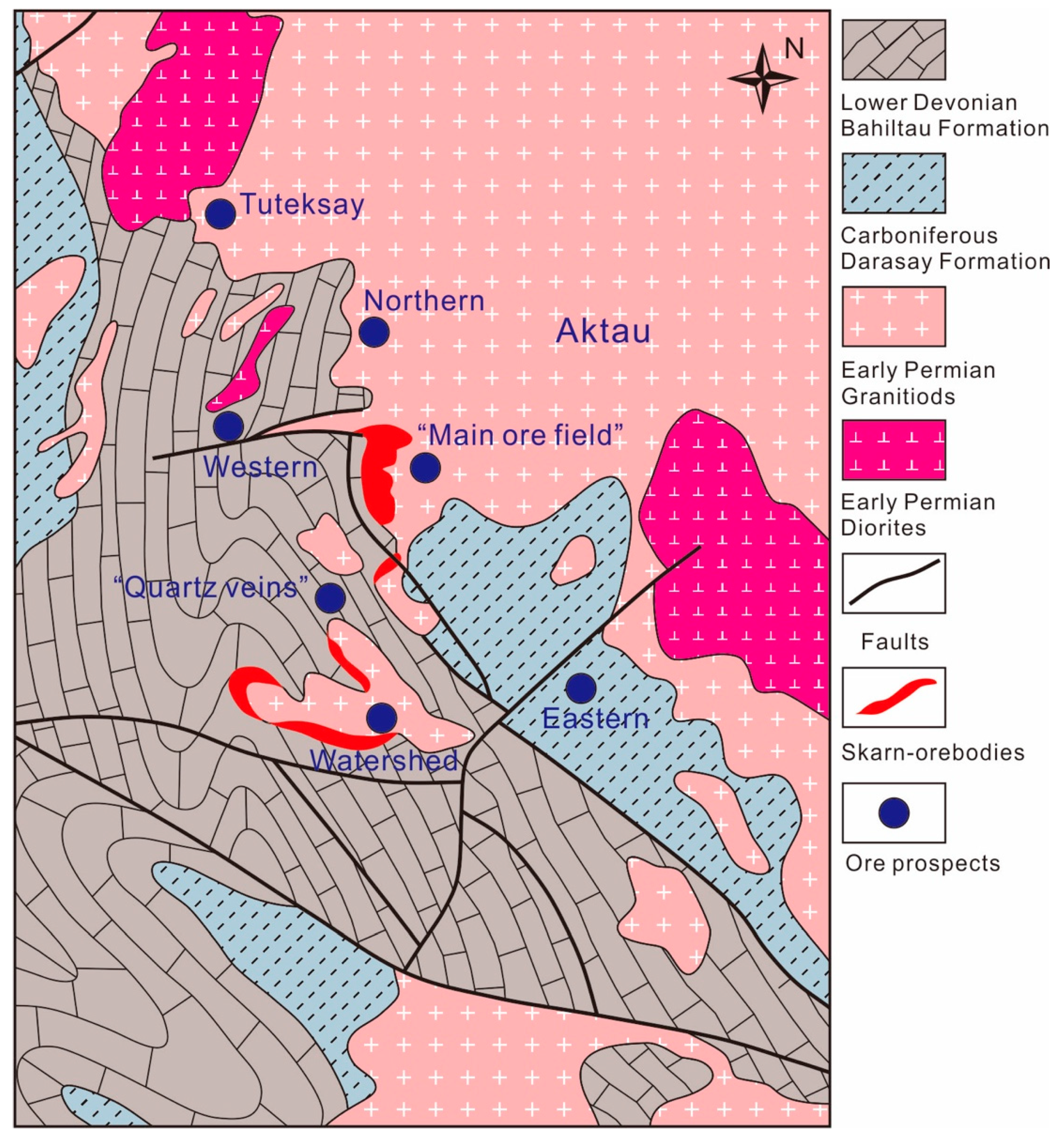
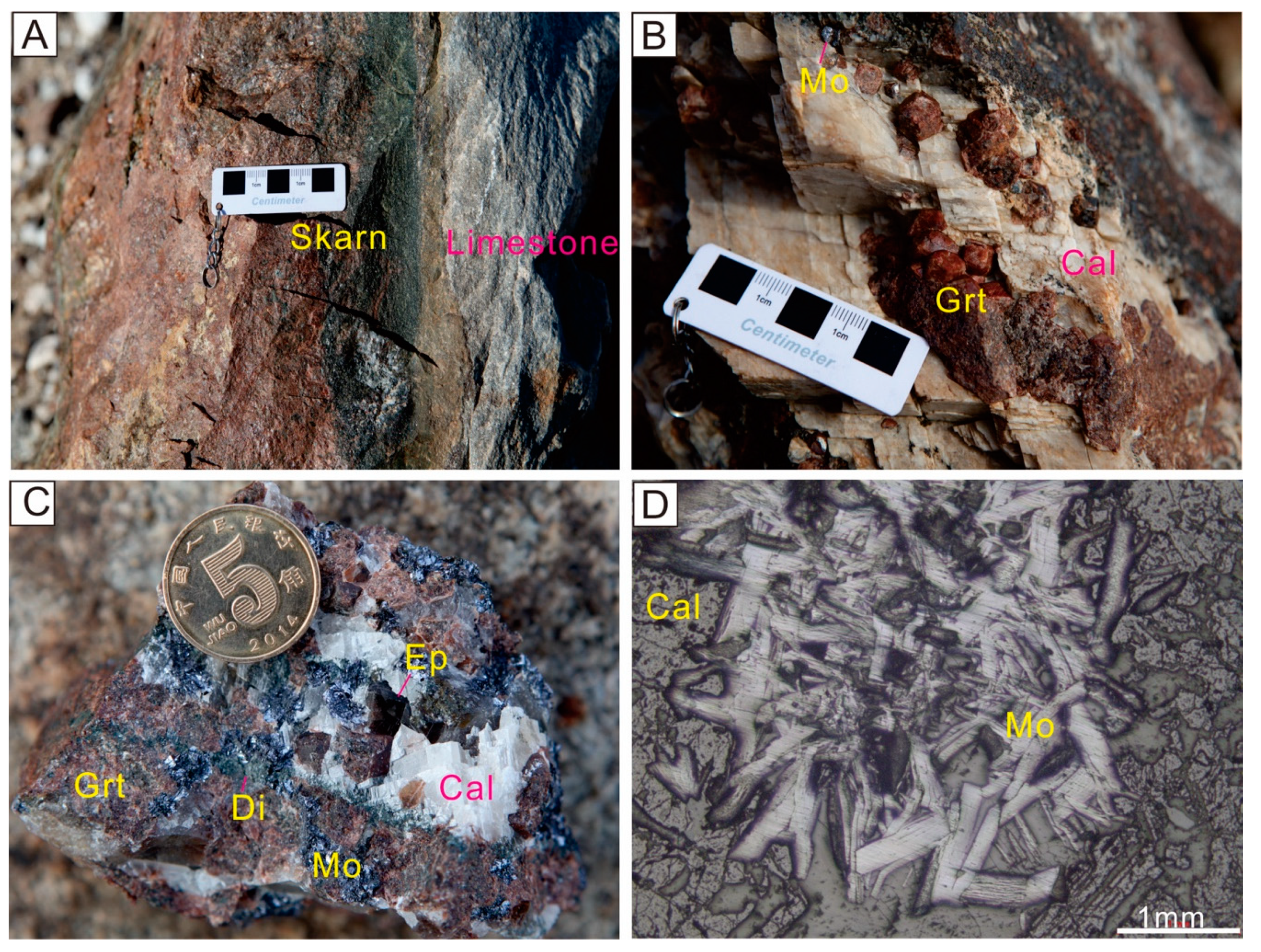
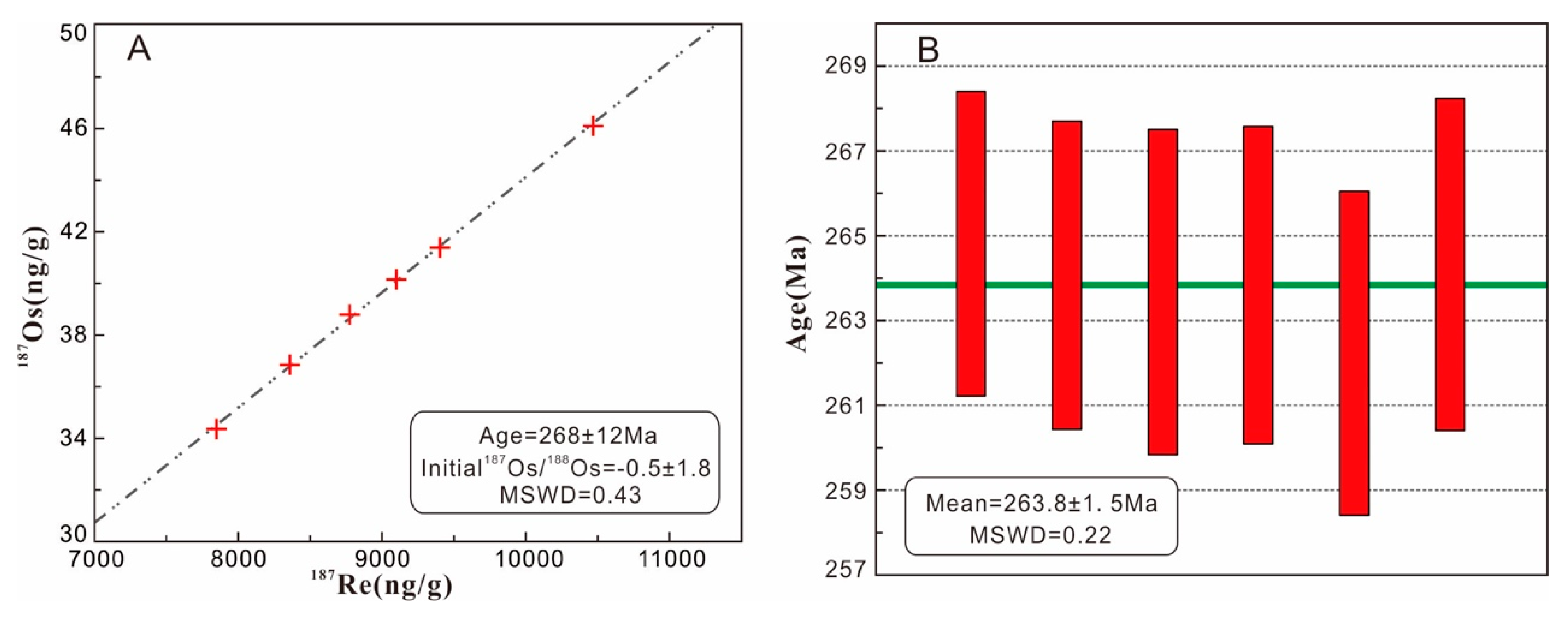
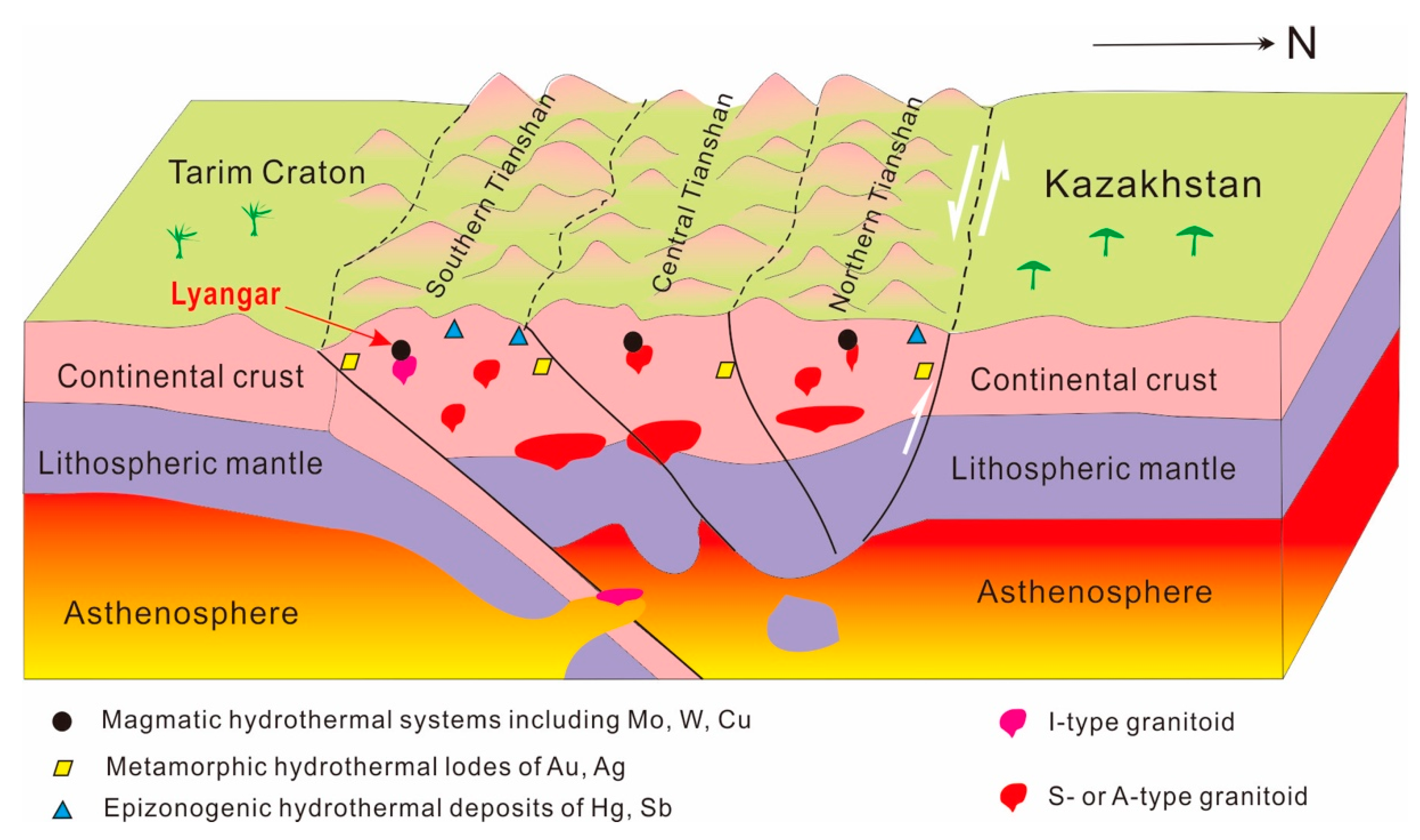
| Sample | Weight (g) | Re (ppm) | Common Os (ppb) | 187Re (ppm) | 187Os (ppb) | Model Age (Ma) | |||||
|---|---|---|---|---|---|---|---|---|---|---|---|
| Measured | 2σ | Measured | 2σ | Measured | 2σ | Measured | 2σ | Age | 2σ | ||
| L1-5 | 0.020 | 13.96 | 0.10 | 0.18 | 0.02 | 8.77 | 0.06 | 38.79 | 0.24 | 264.8 | 3.6 |
| L1-6 | 0.011 | 13.30 | 0.09 | 0.15 | 0.06 | 8.36 | 0.06 | 36.85 | 0.25 | 264.1 | 3.6 |
| L1-7 | 0.012 | 14.96 | 0.120 | 0.04 | 0.05 | 9.40 | 0.08 | 41.39 | 0.30 | 263.7 | 3.8 |
| L1-8 | 0.011 | 16.65 | 0.13 | 0.04 | 0.04 | 10.47 | 0.08 | 46.11 | 0.32 | 263.8 | 3.7 |
| L1-9 | 0.011 | 12.49 | 0.10 | 0.06 | 0.03 | 7.85 | 0.06 | 34.36 | 0.25 | 262.2 | 3.8 |
| L1-12 | 0.015 | 14.48 | 0.12 | 0.15 | 0.03 | 9.10 | 0.08 | 40.16 | 0.29 | 264.3 | 3.9 |
| No. | Sample No. | δ34SVCDT‰ |
|---|---|---|
| 1 | L1-5 | 3.8 |
| 2 | L1-6 | 1.0 |
| 3 | L1-7 | 2.1 |
| 4 | L1-8 | 1.6 |
| 5 | L1-9 | 1.9 |
| 6 | L1-10 | 3.8 |
| 7 | L1-11 | 1.2 |
| 8 | L1-12 | 2.6 |
| Average | 2.3 ± 1.1 |
© 2019 by the authors. Licensee MDPI, Basel, Switzerland. This article is an open access article distributed under the terms and conditions of the Creative Commons Attribution (CC BY) license (http://creativecommons.org/licenses/by/4.0/).
Share and Cite
Zhou, Z.-J.; Chen, Z.-L.; Nurtaev, B.; Shukurov, S.; Han, F.-B.; Wang, Z.-X.; Xiao, W.-F.; Yu, X.-Q. Re-Os Geochronology and Sulfur Isotopes of the Lyangar W-Mo Deposit: Implications for Permian Tectonic Setting in South Tianshan Orogen, Uzbekistan. Minerals 2019, 9, 534. https://doi.org/10.3390/min9090534
Zhou Z-J, Chen Z-L, Nurtaev B, Shukurov S, Han F-B, Wang Z-X, Xiao W-F, Yu X-Q. Re-Os Geochronology and Sulfur Isotopes of the Lyangar W-Mo Deposit: Implications for Permian Tectonic Setting in South Tianshan Orogen, Uzbekistan. Minerals. 2019; 9(9):534. https://doi.org/10.3390/min9090534
Chicago/Turabian StyleZhou, Zhen-Ju, Zheng-Le Chen, Bakhtier Nurtaev, Shukhrat Shukurov, Feng-Bin Han, Zong-Xiu Wang, Wei-Feng Xiao, and Xin-Qi Yu. 2019. "Re-Os Geochronology and Sulfur Isotopes of the Lyangar W-Mo Deposit: Implications for Permian Tectonic Setting in South Tianshan Orogen, Uzbekistan" Minerals 9, no. 9: 534. https://doi.org/10.3390/min9090534
APA StyleZhou, Z.-J., Chen, Z.-L., Nurtaev, B., Shukurov, S., Han, F.-B., Wang, Z.-X., Xiao, W.-F., & Yu, X.-Q. (2019). Re-Os Geochronology and Sulfur Isotopes of the Lyangar W-Mo Deposit: Implications for Permian Tectonic Setting in South Tianshan Orogen, Uzbekistan. Minerals, 9(9), 534. https://doi.org/10.3390/min9090534






